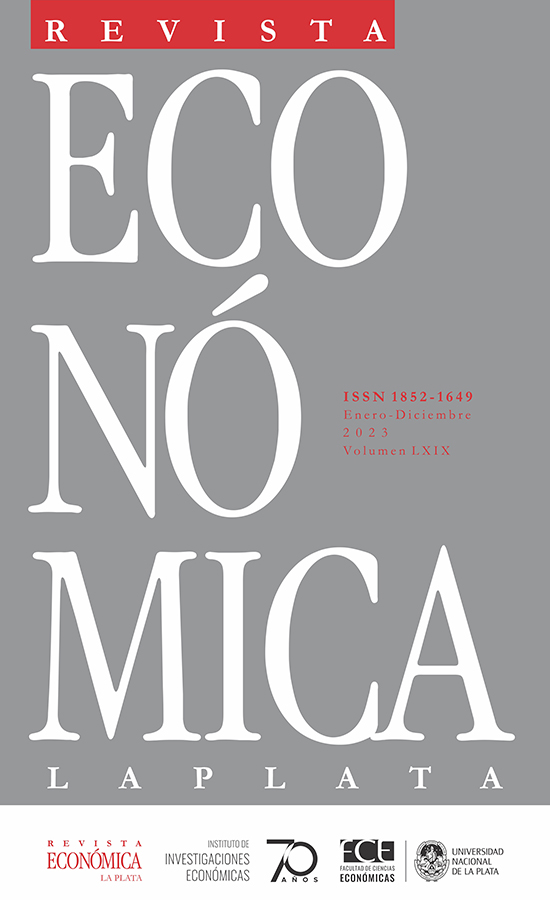Effects of the firstborn on the labor results of mothers: Evidence for Latin America
DOI:
https://doi.org/10.24215/18521649e030Keywords:
Female labor supply, preference for the first son, behavior of mothersAbstract
This research shows that in some Latin American countries women whose first child is a boy are less likely to work than women with firstborns. The object of study is to try to understand why women react that way. For this, the hypothesis of the effect of desire for a child (Dahl and Moretti, 2008) and of the divorce effect (Bedard and Deschenes, 2005; Ananat and Michaels, 2008) were tested, based on an identification strategy that considers that the sex of the first child at conception is random.
Downloads
Metrics
References
Almond, D. y Currie, J. (2011). Human capital development before age five. En D. Card y O. Ashenfelter (Eds.), Handbook of Labor Economics (1ª ed., Vol. 4B, Cap. 15, pp. 1315–1486). Elsevier. https://doi.org/10.1016/S0169-7218(11)02413-0
Ananat, E. O. y Michaels, G. (2008). The effect of marital breakup on the income distribution of women with children. The Journal of Human Resources, 43(3), 611–629.
Azimi, E. (2015). The effect of children on female labor force participation in urban Iran. IZA J Labor Develop, 4, 5. https://doi.org/10.1186/s40175-015-0030-x
Barcellos, S., Carvalho, L. y Lleras-Muney, A. (2014). Child gender and parental investments in India: Are boys and girls treated differently? American Economic Journal: Applied Economics, 6(1), 157–189. https://doi.org/10.1257/app.6.1.157
Bedard, K. y Deschenes, O. (2005). Sex preferences, marital dissolution, and the economic status of women. The Journal of Human Resources, 40(2), 411-434.
Bharadwaj, P. R., Dahl, G. B. y Sheth, K. (2013). Gender discrimination in the family. En E. Redmount (Ed.), The Economics of the Family: How the Household Affects Markets and Economic Growth (Vol. 1, pp. 237 266). Praeger.
Carneiro, P. y Ginja, R. (2014). Long-term impacts of compensatory preschool on health and behavior: Evidence from head start. American Economic Journal: Economic Policy, 6(4), 135-173. https://doi.org/10.1257/pol.6.4.135
Choi, E. J. y Hwang, J. (2015). Child gender and parental inputs: No more son preference in Korea? American Economic Review, 105(5), 638–43. https://doi.org/10.1257/aer.p20151118
Dahl, G. B. y Moretti, E. (2004). The Demand for Sons: Evidence from Divorce, Fertility, and Shotgun Marriage (NBER Working Paper Nº10281). National Bureau of Economic Research
Figlio, D., Hamersma, S. y Roth, J. (2009). Does prenatal wic participation improve birth outcomes? New evidence from Florida. Journal of Public Economics, 93(1-2), 235–245. https://doi.org/10.1016/j.jpubeco.2008.08.003
Firpo, S., Fortin, N. M y Lemieux (2009). Unconditional quantile regressions. Econometrica, 77(3), 953–973.
Gasparini, L. y Marchionni, M. (2015). Bridging Gender Gaps? The Rise and Deceleration of Female Labor Force Participation in Latin America: An overview (Documento de Trabajo Nº185). CEDLAS, Universidad Nacional de La Plata. http://hdl.handle.net/11336/57042
Ichino, A., Lindström, E. A. y Viviano, E. (2011). Hidden consequences of a first-born boy for mothers. Economics Letters, 123(3), 274-278.
Jayachandran, S. y Kuziemko, I. (2011). Why do mothers breastfeed girls less than boys? Evidence and implications for child health in India. The Quarterly Journal of Economics, 126(3), 1485–1538.
Koenker, R. y Bassett, G. (1978). Regression Quantiles. Econometrica, 46(1), 33–50.
Koenker, R. (2005). Quantile Regression (Econometric Society Monographs). Cambridge University Press. https://doi.org/10.1017/CBO9780511754098
Kulczycki, A. (2011). Abortion in Latin America: Changes in Practice, Growing Conflict, and Recent Policy Developments. Studies in Family Planning, 42(3), 199-220. https://doi.org/10.1111/j.1728-4465.2011.00282.x
Levine, P. B. y Schanzenbach, D. W. (2009). The impact of children’s public health insurance expansions on educational outcomes (Working Paper Nº14671). National Bureau of Economic Research.
Lundberg, S. (2005). Sons, daughters, and parental behaviour. Oxford Review of Economic Policy, 21(3), 340–356. https://doi.org/10.1093/oxrep/gri020
Lundberg, S. y Rose, E. (2002). The Effects of Sons and Daughters on Men’s Labor Supply and Wages. The Review of Economics and Statistics, 84(2), 251–268.
Minnesota Population Center. (2020). Integrated Public Use Microdata Series, International (Version 7.3) [Data set]. https://doi.org/10.18128/d020.v7.3
Published
How to Cite
Issue
Section
License
Copyright (c) 2023 Carlos Salas Peña

This work is licensed under a Creative Commons Attribution-NonCommercial-NoDerivatives 4.0 International License.
The material published in the journal is distributed under a Creative Commons Attribution-NonCommercial-NoDerivatives 4.0 International (CC BY-NC-ND 4.0) license. This license requires proper credit to be given, a link to the license to be provided, and changes to be indicated. It does not permit commercial use of the work, and if the work is remixed, transformed, or otherwise modified, distribution of such modification is not allowed.





























